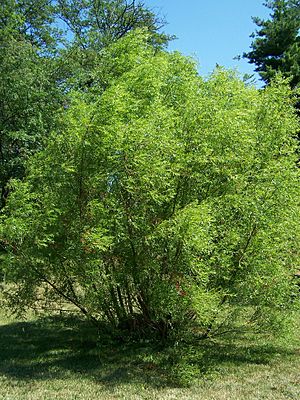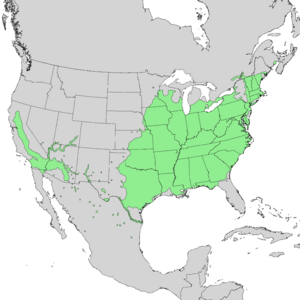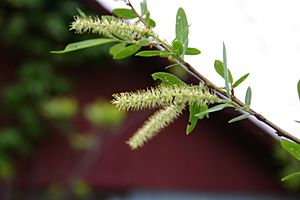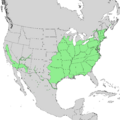Black willow facts for kids
Quick facts for kids Black willow |
|
|---|---|
 |
|
| In the Morton Arboretum | |
| Conservation status | |
| Scientific classification | |
| Genus: |
Salix
|
| Species: |
nigra
|
 |
|
| Natural range | |
The black willow (scientific name: Salix nigra) is a type of willow tree. It grows naturally in eastern North America. You can find it from New Brunswick and southern Ontario in Canada, west to Minnesota, and south to northern Florida and Texas in the USA.
Contents
What Does It Look Like?
The black willow is a medium-sized deciduous tree. This means it loses its leaves every autumn. It is the biggest willow tree in North America. These trees usually grow to be about 10 to 30 meters (33 to 98 feet) tall. Some can even reach 45 meters (148 feet)! Their trunks can be 50 to 80 centimeters (20 to 31 inches) wide.
The tree's bark is dark brown or blackish. As the tree gets older, the bark gets cracks and grooves. Often, the trunk splits into several parts near the bottom. The new branches are thin and can be green, brown, yellow, or purple. They are easy to snap off cleanly at the base.
The leaves are long and thin, about 5 to 15 centimeters (2 to 6 inches) long and 0.5 to 2 centimeters (0.2 to 0.8 inches) wide. They are usually slightly curved, like a sickle. Both sides of the leaf are dark, shiny green, or the underside might be a lighter green. The edges of the leaves have small, fine teeth.
Black willows have separate male and female trees. Their small, greenish-yellow to yellow flowers grow in clusters called catkins. These catkins are about 2.5 to 7.5 centimeters (1 to 3 inches) long. They appear in early spring, at the same time as the new leaves. The fruit is a small capsule, about 5 millimeters (0.2 inches) long. When it's ready, it splits open and releases many tiny seeds covered in soft, downy hairs. In the autumn, the leaves turn a bright lemon yellow color.
Where Does It Grow?
The black willow is found naturally in eastern North America. This includes places like New Brunswick and southern Ontario in Canada, and states like Minnesota, Florida, and Texas in the USA. It also grows in parts of Mexico. While it's native to the east, it has also been planted along streams in Utah.
Black willows grow best in sunny places with wet or moist soil. This is why you often find them along streams, rivers, and in swamps.
Tree Family and Names
The black willow belongs to the Salicaceae family, which is the willow family. Its official scientific name is Salix nigra Marshall. A person named Humphry Marshall first described this tree in 1785. He is sometimes called the "Father of American Dendrology" because he studied trees so much.
Sometimes, another willow called Salix gooddingii (Goodding's willow) is thought to be a type of black willow. However, most experts now see them as different species.
Besides "black willow," this tree is also sometimes called "swamp willow." But be careful, because another tree, Salix myrtilloides, is also called swamp willow! Other common names for Salix nigra include "Goodding willow" and "southwestern black willow." In Spanish, it's called "sauz."
How It Grows and Reproduces
Black willows are dioecious, meaning there are separate male and female trees. They start producing seeds when they are about 10 years old. These trees usually have good seed crops every year.
The seeds need very specific conditions to grow. They like soil that is very wet or even flooded. Once they sprout, they grow very well if they get lots of sunlight and plenty of moisture during the growing season.
Black willows have special ways to deal with floods. When it floods, they can grow special pores (called hypertrophied lenticels) and water roots. These help them survive in wet places. However, black willows don't do well in dry conditions. If there's a drought, their branches and roots don't grow as much.
Largest Black Willows
The biggest black willow tree in the United States is in Hennepin, Minnesota. It is about 19 meters (63 feet) tall. Its trunk is about 9.7 meters (32 feet) around, and its branches spread out about 22 meters (73 feet) wide.
Another very large black willow is the Marlboro Tree in Marlboro Township, New Jersey. This tree is about 152 years old. It stands about 23 meters (76 feet) tall and its trunk is 6 meters (19.7 feet) around. It takes five grown people holding hands to reach all the way around its trunk!
Uses of Black Willow
The roots of the black willow are very bitter. In the past, people used them as a substitute for quinine, a medicine. Native American tribes used black willow for making baskets. They also used it to treat fevers, headaches, and coughs.
People learned that the bark and leaves of the black willow were good for treating pain, especially rheumatism. This is because the tree's bark contains a chemical called salicylic acid. This chemical is very similar to aspirin. In fact, this compound was taken from black willow bark in 1829, even before aspirin was invented!
The black willow is the only native willow species in the United States that is used for timber. Its wood is used to make furniture and shipping containers. In the 1970s, Louisiana was the biggest place for black willow timber production.
The wood of the black willow is very light. It was once used to make artificial limbs, like wooden hands. It also keeps its shape well, doesn't splinter easily, and can handle impacts.
Black willows are also used to help the environment. They are good at resisting animals that try to eat them and can handle floods. They are also used to help stop erosion, which is when soil washes away. Black willows are used in projects to fix or stabilize marshlands. They can even help clean up polluted soil by drawing harmful chemicals into their leaves, where sunlight can break them down.
Diseases of Black Willow
Black willows can get sick from diseases like Crown gall and Cankers.
Crown gall is caused by bacteria in the soil. When a black willow gets infected, these bacteria make the plant cells grow very fast. This causes the tree to form tumor-like growths, called "galls," on its roots or lower branches. As these galls get bigger, they become hard, woody, brown, and rough. Black willows usually don't die from crown galls. However, these galls can stop nutrients from flowing properly through the tree, which can slow down its normal growth. Crown galls are less of a problem in more acidic soils.
Black canker disease is caused by a fungus called Glomerella miyabeana. This disease starts as spots on the leaves. Then it spreads to the leaf stem and eventually to the twig or branch holding the leaf. It forms black patches on the tree's stem that can get bigger. Black willows that are not getting enough nutrients or are stressed by bad weather (like a short drought) are more likely to get these cankers. The parts of the tree affected by cankers won't grow with the rest of the tree, and cracks will start to form.
Images for kids
See also
 In Spanish: Sauce negro para niños
In Spanish: Sauce negro para niños






